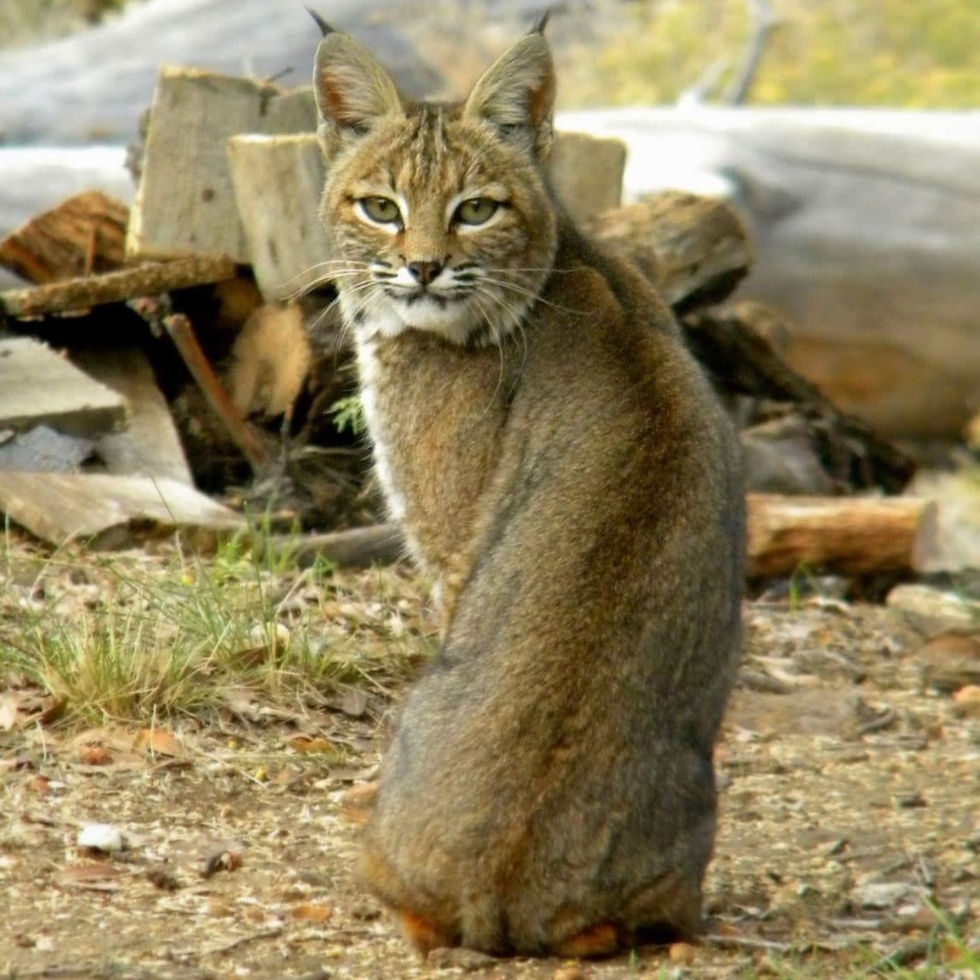Living Among Wildlife
- Eva Hatch

- Apr 7, 2021
- 6 min read
Updated: Sep 30, 2021

You ain't in the city anymore. The wild west is full of wildlife. Bugs, coyotes, mountain lions, turkeys, and deer are just a part of country living. Living among the wildlife has many pros and cons. I frequently have to stop to let the turkeys cross the street. It can be annoying, but it’s just one of those things you have to laugh at. There’s nothing quite like catching a glimpse of a bald eagle soaring or seeing a mountain lion for the first time. On the flip side, rural residents are reminded of the harsh circle of life from time to time. If you are going to live a rural lifestyle, you have to learn how to live among the wildlife.
Living here is a constant balancing act between safety and preserving the natural ecosystem. To be frank, if you can’t handle rodents, bugs, and large wild animals, you might want to consider an urban place to call home. It is possible for humans and animals to coexist as long as you are willing to make a few lifestyle changes. Personally, I have not had too many negative encounters with wildlife in San Diego County. There have been a few times when we needed to address infestations and unwanted guests. For the most part, we leave the animals alone.
There are a variety of opinions on how to live among the wildlife. Sometimes, despite your best efforts to responsibly mitigate a situation, it might not be enough to protect yourself and others. At this point, you may need to take additional measures to ensure safety.
Keep Wildlife Wild
More often than not, frequent wildlife sightings happen for a reason. Things like bird feeders, a consistent water source, shelter, pets, compost, unprotected trash, and plants often attract not only wanted but also unwanted animals. By simply removing or animal-proofing these items, you may be able to solve an animal problem. It’s okay to occasionally feed the birds or put out water during heat waves. It is not healthy, though, when the wildlife becomes dependent on humans. We have to keep the wildlife wild.
Pets
Unprotected pets are easy prey for medium to large wild animals. Small animals like rabbits, chickens, cats, and lapdogs should be kept in sturdy enclosures that raccoons, foxes, coyotes, bobcats, and mountain lions can not get into. Pets should not be left out past late afternoon. Pet food left outside will attract wildlife. I highly encourage dog owners to put their dogs through rattlesnake training.
Rodents
Yes, there are rodents in the backcountry. Even if you don't see evidence of them, they are still there. An out-of-control rodent problem is not healthy. The sooner the dilemma is addressed, the better it is for you and the environment. Please do not use poisons to kill pests. As we will discuss below, there are alternative ways to control the rodent population.
One of the most common issues is rodents getting into rooms or buildings that are infrequently used. By storing everything in sealed plastic bins, you remove the nesting potential and protect your items. Installing a motion sensor light is also a good way to deter them. Rodents eating car wires is another common problem. I have heard that some car brands use materials that attract rodents more than others. A few solutions are keeping the car hood up, placing motion sensor lights in the parking area, peppermint, and Irish Spring soap. It might be financially worth buying comprehensive car insurance that covers damage from rodents.
If you are going to plant anything in your yard, it needs to be a plant that can survive in the local climate, and it has to be planted in a gopher basket. You can easily make one of these with gopher wire. My mom always says to make the basket large enough for the plant to grow in and tall enough to stick up out of the ground a few inches.
When precautionary measures aren’t enough, fostering an environment that allows rodent predators to thrive is an ideal situation. Putting up an owl box is a great option. Once again, please do not use toxic products that will harm the food chain.
Outdoor/barn cat(s) can really help manage the rodent population. Just be mindful of how many cats you have—they can also decimate the native bird populations. Spay and neuter them to prevent uncontrolled breeding.
Personally, I have had success with using reusable traps for rodents in the house. There are two keys to catching them. First off, the trap needs to be placed in an area they move about in like along walls or behind objects. Secondly, the bate (I use chocolate) needs to be a small piece so the rodent must step on the trigger to reach the bate. If you don't catch anything in a couple of days move the trap to a different location. I placed a number of traps along the same wall all within a few feet of each other and regularly trap nice in the same trap. Not sure why I don't catch any in the other traps.
I will note that I originally used live traps for relocation. I found it very hard to get the mice out of the trap. It was so stressful I felt horrible.
Many residents have reported that they have been able to capture large numbers of rodents, including squirrels, in live traps with chicken scratch. You can then relocate the animals miles away from your home or exterminate them in a variety of humane ways. If you are relocating them, release them only in open lands and not in someone else’s yard.
And of course, there’s the redneck way. Shooting the rodents is a method of dealing with the problems outside.
Bugs
Bug infestations are frequent in the warmer months. Native birds and chickens are a great way to keep the insect populations under control outside. For inside your home, some residents have reported success with using essential oils on doorways. Make sure the oil blend you choose is safe for your pets. A vacuum and electric fly swatter are also options. Don’t worry; the bugs will eventually go away in the colder months.
If you have a pond, you can get mosquito-eating fish or ducks.
Please do not kill bees. There are multiple local individuals who will remove and relocate the bees for you. They tend to be attracted to hummingbird feeders and water. Sometimes by removing those items you can solve the problem. I have also heard they don’t like peppermint.
Woodpeckers
We haven't found a successful way to deter woodpeckers from pecking at our house. Some suggest CDs, bird reflectors, and laser lights. None of that has worked in my experience. Cement siding seems to be the best solution. All woodpeckers are protected under the Migratory Bird Treaty Act so shooting them is not recommended.
Deer
It’s always a nice surprise to see a deer out the window. It’s not so nice when they eat your whole garden. Over the years, my mom has tried a variety of methods from Irish Spring soap to blood meal, and nothing has worked. I recommend planting varieties they do not like to eat, installing deer fencing, or being prepared to share.
Snakes
Having snakes in your yard will help naturally regulate rodent populations. The catch is, rodents attract snakes. I recommend using other methods discussed above to handle rodent problems. Several species of native snakes are harmless. During the warmer months, though, residents need to keep a very watchful eye out for venomous snakes like rattlesnakes. Just about every rattlesnake I have come across, I’ve almost stepped on. Yes, I was actively watching for them. Rattlesnakes are important for the ecosystem, but they are incredibly dangerous.
A well-groomed yard not only deters them, it allows you good visibility. It is also necessary to reduce fire danger. Snakes like piles of any material, tall grass, and things leaning against the house. Remove any potential hiding spots. Remove all water sources including leaky faucets. When walking around at night, always use a bright flashlight to see the ground. I always keep my car windows up and doors shut. The same goes for the house. Pets need to go through rattlesnake training. Owning a snake pole or two long shovels for safe removal is a good idea.
High On Kennels specializes in bird dog training, obedience training, behavioral problem solutions, and rattlesnake aversion training. 760-782-0728 https://www.highonkennels.com/
Caring for the Sick
It’s not unusual for rural residents to come across injured animals. Here are a few resources in San Diego County.
Ramona Wildlife Center
18740 Highland Valley Rd,
Ramona, CA 92065
619-299-7012
Project Wildlife Drop-Off Location
Pilar & Chuck Bahde Wildlife Center
5433 Gaines St.
San Diego, CA 92110
619-) 225-9453
Drop-off area is open 24/7, and there is dedicated parking.
San Diego Fawn Rescue - Call 858-549-4149 or 858-603-0170
Fish and Game - Call 760-535-5735
Hummingbird Rescue Center - Call 619-420-5156
Sky Hunters - This organization cares for raptors, 619-985-9686
Fund For Animals - They care for bobcats, coyotes, skunks, raptors, and bear cubs. Call them at 760-789-2324
California Department of Fish & Wildlife - Call them for all mountain lion situations. They will determine the best next steps. 858-467-4201
Julian Animal Hospital - 760-765-0500
VCA Adobe Animal Hospital - This Ramona-based vet is frequently used by Julian pet owners. 760-789-7090














Comments